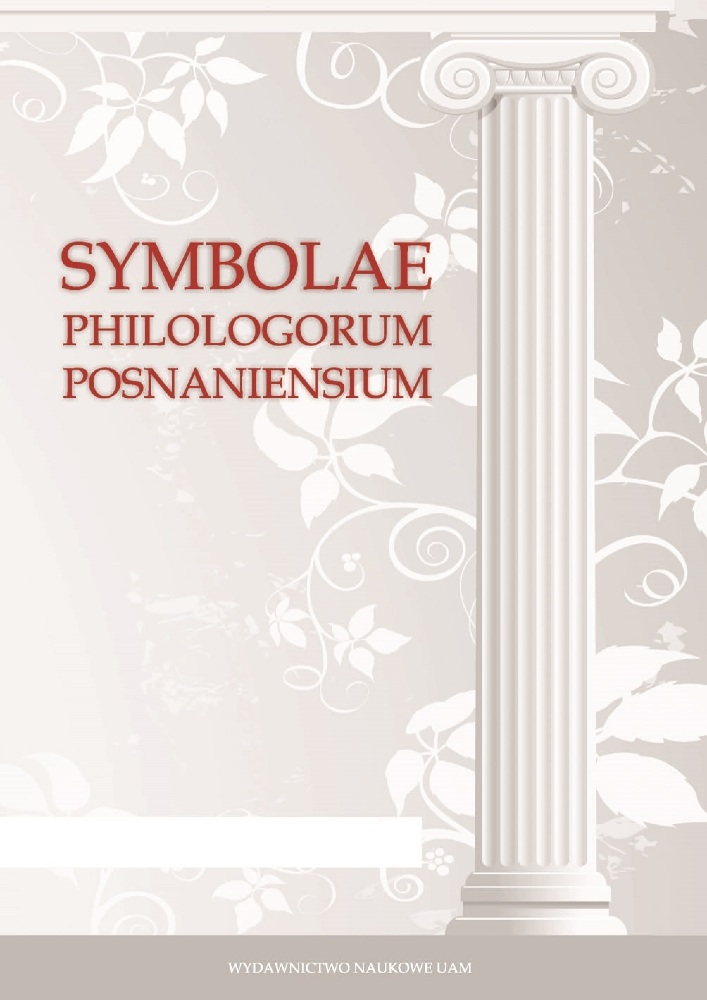Abstrakt
This article discusses the various problems one faces as a teacher of Latin in Poland. These problems are partly due to the permanently decreasing number of Latin lessons in schools. This decrease, however, has not been considered by those responsible for the core curriculum, which is now too extensive and does not match the amount of time provided for Latin classes. The lack of reform in the didactics of Latin also takes its toll (namely the continuous usage of the grammar-translation method). Direct methods, which include dr. Rouse’s method, Ørberg’s method and Assimil method (all discussed briefly in this article) could prove to be a useful solution to these problems.Bibliografia
Ávila Mario Díaz, Alexandros – to hellenikon paidion, Granada 2014.
Bobiatyński Lech, Wprowadzenie do kultury antyku a nauczanie języków klasycznych, „Collectanea Philologica V”, Łódź 2003, s. 207–219.
Capelle Jean, Latin or Babel, „The Classical Journal”, vol. 49, nr 1, Oct. 1953, s. 37–40.
Fritsch Andreas, De educationis condicionibus mutatis et Latine docendi rationibus mutandis, „Acta Selecta Octavi Conventus Academiae Latinitati Fovendae (Lovanii et Antverpiae, 2–6 Augusti MCMXCIII)”, Roma 1995, s. 777–796.
Fritsch Andreas, Lebendiges Latein – was ist das und wer spricht es?, [w:] „Plansprachen und ihre Gemeinschaften, Beiträge der 11. Jahrestagung der Gesellschaft für Interlinguistik e.V. 23.–25. November 2001 in Berlin”, Berlin 2002, s. 53–67.
Golias Marjan, Nauka języków klasycznych w programie naszej szkoły średniej, „Kwartalnik Klasyczny” 1927, I 1, s. 16–25
Golias Marjan, O metodę rozumienia tekstów łacińskich w szkole, „Kwartalnik Klasyczny” 1934, VIII 1, s. 9–21
Jones Wiliam Henry Samuel, Via Nova or The Application of the Direct Method to Latin and Greek, Cambridge 2013 (pierwsze wyd. 1915)
Kabat Michał, Nauka języka starogreckiego w sposób czynny – metoda Polis, „Nowy Filomata” 2015 nr 1, s. 134–136.
Krzyżanowski Juliusz, W liceum mówimy po łacinie i po grecku, „Przegląd Klasyczny”, 1936, II 7–8, s. 537–540.
Krzyżanowski Juliusz, Żywa łacina, „«Prosto z Mostu» Tygodnik Literacko-Artystyczny”, nr 44 (152) niedziela, 26 września 1937, s. 5.
Krzyżanowski Juliusz, Żywa Łacina (system dr Rouse’a), „Przegląd Klasyczny”, 1937, III 9–10, s. 669–680.
Lenkowski Stanisław, Uwagi o obecnym programie łaciny, „Przegląd Klasyczny”, 1937, III 9–10, s. 665–668.
Lewicki Tadeusz, Gimnazjum humanistyczno-realne i nauka łaciny, „Kwartalnik Klasyczny” 1927, I 4, s. 274–289.
Loch Marcin, Żywa łacina – między prawdą a mitem. Zarys historii zagadnienia, „Language and Literary Studies of Warsaw” 2013, nr 3, s. 153–170.
Miraglia Luigi, Latino e greco alla prove – la verifica delle competenze nella didattica delle lingue classiche, „Docere” 2002, nr 1 – s. 23–33 oraz nr 2. s. 16–29, https://vivariumnovum.it/risorse-didattiche/propria-formazione/docere (dostęp 12.12.2015)
Miraglia Luigi, Lingua Latina per se illustrata. Nova via – Latine doceo. Guida per gl’insegnanti, Montella 2009.
Ochman Katarzyna, Nauczanie łaciny. Immersja czy gramatyka?, „Języki Obce w Szkole”, 3/2014, s. 54–58.
Ogrodziński Wincenty, Dola i niedola filologii klasycznej w dzisiejszych gimnazjach polskich, „Kwartalnik Klasyczny” 1927, I 3, s. 198–207.
Ørberg Hans Henning, Lingua Latina per se illustrata, pars I Familia Romana, pars II Roma aeterna, Domus Latina 2009.
Osipowicz Anna, Jak rozumiem pojęcie LATINITAS VIVA – na podstawie praktyki szkolnej w liceum i pracy nad podręcznikiem ROMA LATINE DICTA, „Collectanea Philologica V”, Łódź 2003, s. 221–229.
Podstawa programowa języka łacińskiego i kultury klasycznej, http://men.gov.pl/wp-content/uploads/2011/02/7g.pdf (dostęp: 12.12.2015) oraz http://static.scholaris.pl/main-file/102/679/jezyk_lacinski_i_kultura_66067.pdf (dostęp: 12.12.2015)
Program nauki w gimnazjach państwowych. Język łaciński (projekt). MWRiOP, Lwów 1933: http://pbc.biaman.pl/dlibra/doccontent?id=17168 (dostęp: 12.12.2015)
Rico Christophe, Polis – Parler le grec comme une langue vivante, Paris 2009.
Rico Christophe, The „Polis” Method, https://www.academia.edu/18712650/The_Polis_Method (dostęp: 12.12.2015)
Rouse William Henry Denham, The Direct Method Applied to Latin, a Handbook for Teachers, London [b.r.]
Rouse William Henry Denham, The Greek Boy at Home, London 1909.
Rosenthal Georg, Lebendiges Latein! Neue Wege im Lateinunterricht, Oldenburg & Leipzig 1924.
Sadowska Joanna, „Jędrzejewiczowska reforma oświaty w latach 1932–1933” (rozprawa doktorska), Uniwersytet w Białymstoku 1999 r., http://repozytorium.uwb.edu.pl/jspui/bitstream/11320/3123/1/doktorat.pdf (dostęp 12.12.2015)
Stroh Wilfried, Lebendiges Latein, DNP, Rezeptions- und Wissenschaftsgeschichte, Bd. 15, Stuttgart & Weimar 2001, Sp. 92–99.
Wolanin Hubert, Techniki bezpośrednie w nauczaniu łaciny, „Języki Obce w Szkole”, rok XXXVI, maj–czerwiec 1992, 3 (178), s. 205–207
Wolanin Hubert, Kształtowanie i kontrola sprawności rozumienia tekstu łacińskiego, „Języki Obce w Szkole”, rok XXXV, maj–czerwiec 1991, 3 (173), s. 195–198.
Licencja
